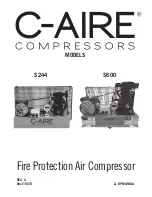
INSTALLATION
CB9A-005 page 6/28
NOTICE:
Blackmer compressors must only be installed in
systems designed by qualified engineering personnel.
System design must conform with all applicable
regulations and codes and provide warning of all
system hazards.
NOTICE:
This compressor shall be installed in accordance with the
requirements of NFPA 58 and all applicable local, state
and national regulations.
Install, ground and wire to local and
National Electrical Code requirements.
Install an all-leg disconnect switch near
the unit motor.
Disconnect and lockout electrical power
before installation or service
Hazardous voltage.
Can shock, burn or
cause death.
Electrical supply MUST match motor nameplate
specifications.
Motors equipped with thermal protection automatically
disconnect motor electrical circuit when overload exists.
Motor can start unexpectedly and without warning.
LOCATION AND PIPING
Compressor life and performance can be significantly
reduced when installed in an improperly designed
system. Before starting layout and installation of the
piping system, consider the following:
1. All piping must be leak free to a pressure of 1.5 times
the maximum system pressure.
NOTICE: If the system is to be hydro-statically
tested, the compressor MUST be isolated. Liquid
entering the compressor will cause damage and
void the warranty.
2. A strainer should be installed in the inlet line to
protect the compressor from foreign matter. A #30
mesh screen or finer is recommended. Strainers
must
be cleaned every 180 days, or more frequently
if the system requires.
3. Expansion joints, placed within 36" (0.9 m) of the
compressor, will compensate for expansion and
contraction of the pipes. Contact the flexible
connector/hose
manufacturer
for
required
maintenance/care and design assistance in their
use.
4. Piping
must
be adequately supported to ensure that
no piping loads are placed upon the compressor.
5. Both suction and discharge piping should slope
down from the compressor. The compressor should
not be placed at a low point in the piping system.
Discharge piping surface temperatures
may be hot during operation (over
158°F, 70°C). Temperatures should be
monitored and adequate warnings
posted.
Extreme Heat can
cause personal injury
or property damage
MOUNTING THE COMPRESSOR UNIT
Stationary Compressors
A solid foundation reduces
noise and vibration, and
will improve compressor
performance.
On
permanent installations, it
is
recommended
the
compressor be secured by
anchor bolts as shown.
This arrangement allows
for slight shifting of position
to
accommodate
alignment
with
the
mounting holes in the base
plate.
Fig. 3 - Anchor Bolt
Set the anchor bolts in concrete for new foundations.
When compressors are to be located on existing
concrete floors, holes should be drilled into the concrete
to hold the anchor bolts.
To keep vibration at a minimum, in addition to a solid
concrete foundation, it is important that the concrete be
located on a stable soil foundation. The base must have
complete contact along its entire length with the
foundation. Visible separations will result in vibrations
which are magnified in the upper part of the unit.
See CB220 “Compressor Bases, Skids and
Foundations” for additional information.
Truck Mounted Compressors
Blackmer compressors may be mounted to the frame
rails of a truck/transport and driven by either a V-belt or
PTO drive.
The compressor should be solidly mounted and care
should be taken to ensure that the dipstick and
inspections plates are readily accessible.
Check compressor mounting bolts and baseplate anchor
bolts regularly.







































